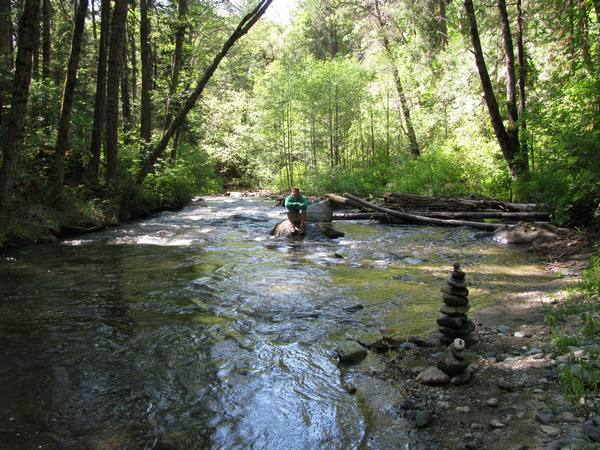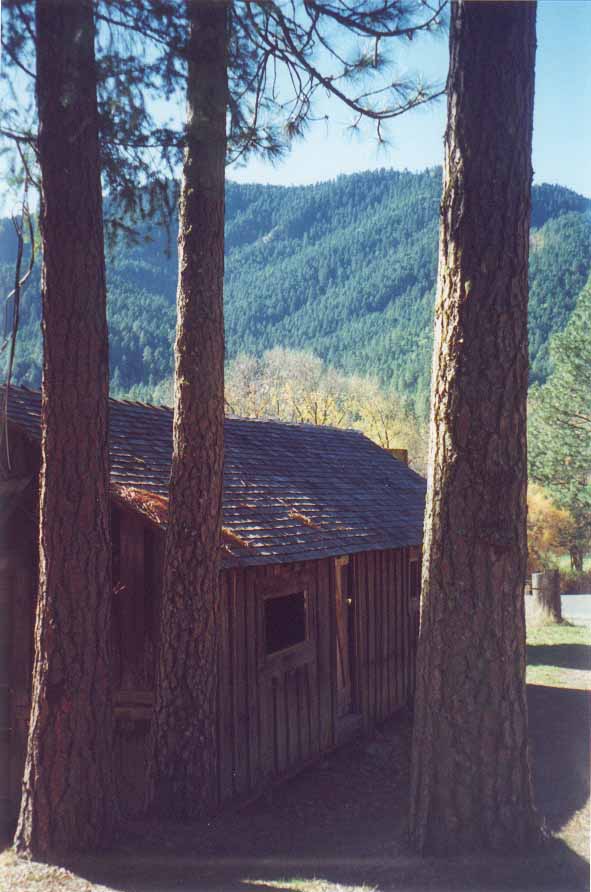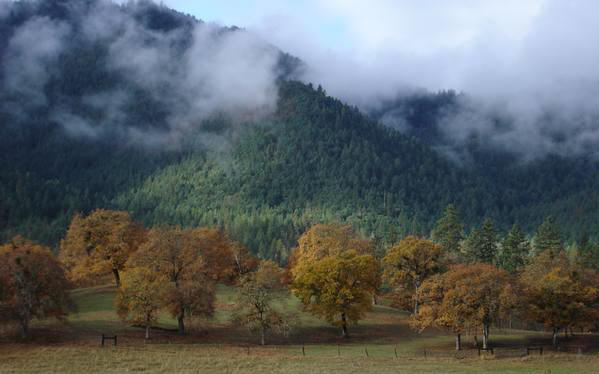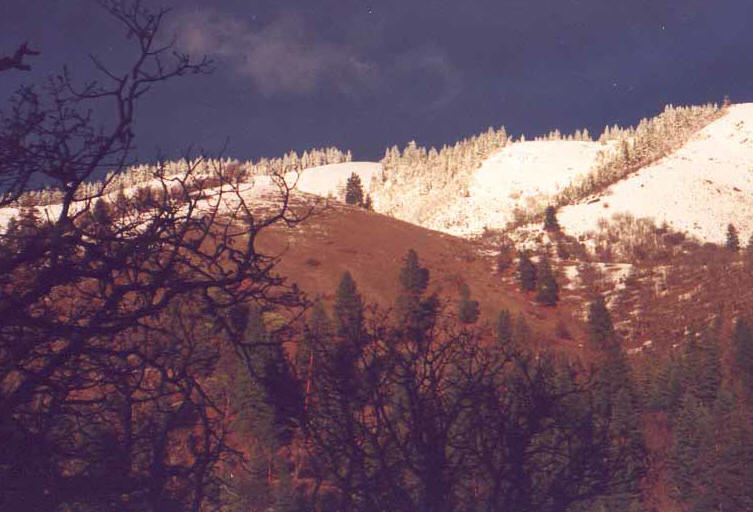Threatened & Endangered: Little Applegate Valley
The Little Applegate Valley
Photo:© Chant Thomas
Little Applegate Valley above Buncom.The Little Applegate Valley. What images come to mind when we read those words? Home. Ranches. Farms, Buncom. Mountains. Forests. And a splendid little river.


All photos:© Chant Thomas
Clockwise from upper left: old-growth forests fill the canyon of the Little Applegate River below Wagner Butte;
old barn on a historic Little Applegate ranch; Little Applegate River meditation;
one of the Monogram Lakes on Big Red Mountain; historic Buncom; snowy Goat Cabin Ridge.
The Little Applegate Valley is home to several dozen households, providing a place to live close to nature with clear air, clean water, and the inspiration of a beautiful landscape. The Little Applegate is also a refuge for our friends and people from town and distant places who come here for renewal; to hike, picnic, hunt, swim in the river, do some birding and botanizing.The U.S. Constitution guarantees citizens the right to life, liberty, and the pursuit of happiness. As residents and visitors to the Little Applegate, we have a responsibility to defend the natural landscape of our watershed that provides the quality of life necessary to really enjoy our constitutional rights. The Dakubetede, Athabascan-speaking native people who lived for countless generations in 3 small villages along the river, understood this responsibility. Nearly everything they used and consumed came directly from this landscape. Their very survival depended on their careful stewardship to enhance, rather than degrade, their natural resource base.
Beyond people, the Little Applegate watershed is a critically important connection from the western Siskiyou Mountains to the heavily forested Ashland watershed and east to the Cascade Range. This is a crucial bioregional corridor for the migration of plants and animals. Compared to other heavily cut ridges in the eastern Siskiyous, three main ridges in the Little Applegate watershed (Wagner Butte-Bald Mt.-Anderson Butte, Big Red-Sevenmile Ridge, Little Red-Yale/Glade Divide) are still relatively intact, providing important connectivity from high to low elevations.
Large scale logging operations began in the Little Applegate shortly after World War II as some of the best forests were cut on land acquired by private timber companies through the land scandals of the Oregon and California (O&C) Railroad. The 1960’s saw the beginning of 4 decades of widespread logging of our public forests as the US Forest Service and Bureau of Land Management (B.L.M.) moved from a stewardship role to a timber extraction agent for an increasingly corporatized timber industry. This era witnessed the transformation of diverse and complex forests into monoculture wood-fiber plantations that often failed, growing into choked brushfields with many alien weed species. It is no coincidence that this era also saw an unprecedented series of major floods and landslides in 1955, ’64, ’74,and ’97.
To prevent further catastrophe, we must stop using our public forests primarily as timber baskets for an industry that already has destroyed thousands of acres of the most productive forests in our region. It is time for the B.L.M. and Forest Service to stop large-scale commercial timber extraction and to begin restoring our shattered ecosystems. It is time to decommission many miles of unnecessary and unstable logging roads that slide and erode into the creeks and river.
It is time to restore these creeks and river so salmon, steelhead, and trout once again reach thriving populations. It is time to stop creating landscape disturbances that provide opportunities for alien plants to invade and threaten the ecological integrity of our public lands. It is time to reduce the fire hazard of logging slash and thinned plantations in the roaded portions of the watershed. It is time to preserve all remaining natural and wild areas within the Little Applegate watershed, and to stop the agency arrogance that advocates experimental intensive management of nearly every acre. Most important, it is time for all of us who care to contribute to the efforts to make these changes now, before it is too late.
We must now educate ourselves and take action against the threats to this valley, particularly the threat of our Applegate BLM forests being turned over to a Timber Trust that would clearcut 23,000 acres each year in western Oregon, as provided by the Oregon State Forest Practices Act, the most toothless such law in the US. No one will be able to escape the impacts of logging, whether visual intrusion, shattering of quietude by helicopters and log trucks working at dawn, contamination from herbicides applied by helicopter, or an increase in the fire danger due to slash.
We have not always had the foresight necessary to predict the cumulative effects that timber extraction has on the ecosystem—including humans. The impacts of past logging must be adequately considered, and experimental forest management practices need to be monitored and evaluated before implementation in a project of this scale. Protecting our unlogged forests and roadless areas enhances our land, water, air, and quality of life more than we often realize.
Land
Several timber-related landslides in California and Oregon have dramatized the catastrophic effect that cutting a large percentage of trees can have. Tree roots form a complex network that holds soil on steep slopes. After large trees are cut, the roots die and the soil begins to slide.Fire suppression is the motivation for many of the current timber sales. Ironically, the threat of fire due to post-logging slash actually increases for several years following a cut. The abundant, small trees that are a real fire hazard are usually not removed in BLM timber sales.
The funding necessary to maintain or decommission old logging roads is severely lacking—we cannot afford to create more. These roads erode and degrade the landscape. In some areas, logging road densities are several miles of dirt roads per square mile of forest.
Forest Service and BLM data maps confirm that non-native invasive species (such as star thistle), which threaten the biodiversity of the area, mainly plague areas along dirt roads.
Water
The quality of our water is also directly tied to the health of the forests in our watershed.Siltation affects water clarity. This means that our water filters and pumps for irrigation systems would become clogged more easily and might not be able to remove the finest sediment, discoloring the water. Additionally, salmon and other fish are not able to spawn where silt fills in beds and covers eggs.
A significant amount of the precipitation in this area is not produced by rain or snow but by the ability of large conifer trees to absorb moisture from low-elevation clouds, a process known as "fog drip." Fewer forests mean less water.
Streams tend to flow less regularly as heavy cutting destroys the ability to slow down, hold and release the water. In areas with fewer trees, winter sun will melt exposed snow pack, causing rapid snowmelts and leading to frequent and more severe floods. At the end of the summer, droughts will become more likely as there is less shade to slow evaporation. Changes in water flow due to timber harvests directly impact well-recharge areas and irrigation, afflicting gardens, agriculture, and livestock operations in the valley.
Air
Log truck traffic creates significant noise, dust, fumes, and washboards along roads. Jake brakes are particularly noisy.Trees serve as the "lungs" for our environment. They remove carbon dioxide, which we exhale, and produce oxygen, which is necessary for our respiration. At a time when automobile and industrial air pollution is a tremendous problem, cutting down trees is similar to removing sections of our own lungs.
The use of helicopters creates noise and a visual setting that one resident described as "a war zone." In past logging on Thompson and Sterling Creeks, helicopters often operated 7 days a week, beginning at dawn. The loss of rural quiet is a severe, if temporary, degradation of the quality of rural life.
How different would Buncom look without the tree-covered mountain across the river? The residents and friends of the Little Applegate Valley have the greatest investment in the protection of this beautiful land, and the greatest imperative to take action. We need to consider our reasons for living here—among them healthy land, air, and water—and then stand for our forest stands. Love Where You Live; Defend What You Love!
Threatened & Endangered: Little Applegate Valley
PO Box 1330
Jacksonville, OR 97530


